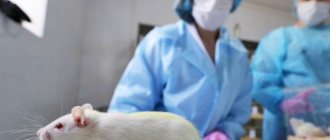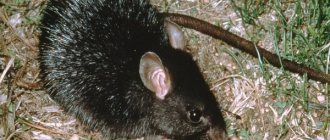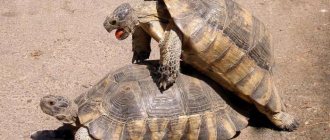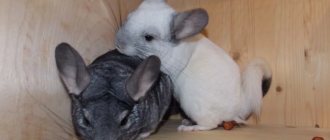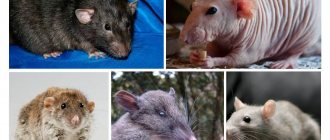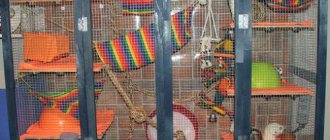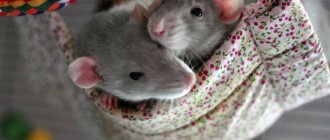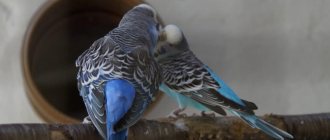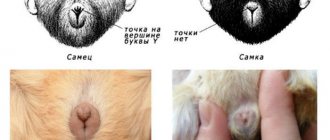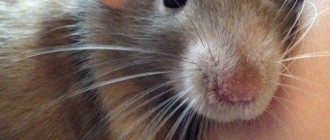Often people, not knowing how rats reproduce, often breed smart rodents in opposite-sex couples so that the animals do not get bored in the absence of the owner.
For the owner, the little smart lumps are still just children; as a result, the owner risks early pregnancy and pathological childbirth in the female. If you don't seed the droppings in time, you can start a rat conveyor belt. To exclude such cases, it is necessary to know the physiology of these animals and how to properly breed rats. Breeding rats at home is a very responsible step; the owner must be prepared to care for a pregnant female and her cubs and the problem of distributing babies at one month of age.
Features of breeding decorative rats
If rats of different sexes become cage neighbors, the female will inevitably bear offspring. Important factors when mating rodents include proper nutrition of the rodents. To do this, you need to provide them with greens and clean, fresh water.
IMPORTANT! You should not overfeed rodents, as this negatively affects the birth of healthy rat pups.
If one of the animals is sick, mating should be postponed. It would not be superfluous to move the couple to a more convenient place, preferably spacious, during mating.
IMPORTANT! Puberty in rats begins after five weeks of birth.
Types of Rat Breeding
There are four types of breeding of ornamental rats.
Linear crossing or in other words Linebreeding is the crossing of a pair that is assumed to have a common ancestor.
Breeding rodents by inbreeding involves studying the gene pool of the rat and selecting healthy females among relatives in order to consolidate the important qualities of the breed.
To increase the number of healthy litters, the “ Outcrossing ” type of breeding is used.
And to improve the quality of the breed, the Outbreeding .
Linebreeding
The linebreeding method allows you to achieve the result of viable offspring with a good genotype. When choosing breeding rats, it is worth considering that he must have good natural characteristics and be the best individual of the 3rd generation.
Inbreeding
This method is very complicated because it is necessary to thoroughly study the gene pool of the rodent. This method is characterized by a particularly strict and careful selection of rats who are closest relatives . Rats that meet the requirements will be used in the future to increase the purity of the natural line.
There is such a thing as inbred depression . It is characterized by a decrease in the number of viable individuals obtained as a result of the inbreeding method. Breeders of decorative rats often encounter this. This can only be avoided by screening out and destroying rodents that do not meet the requirements of the method.
Outcrossing
To use the Outcrossing method, rats obtained by linear crossing (Linebreeding) are taken. It is desirable that they do not have common ancestors of the third and fourth generations.
To obtain a clean line, unsuitable rodents are removed from each subsequent litter.
Outbreeding
The Outbreeding method is very similar to the natural breeding method. For this purpose, purebred rodents that do not have common ancestors are selected.
IMPORTANT! Despite all the advantages that the Outbreeding method provides, there is a risk that apparently satisfying females may produce offspring with undesirable characteristics.
And the Outbreeding method is full of advantages. But if you want to improve your offspring, you shouldn’t rely on it completely.
Artificial feeding
In some cases, when the female dies after giving birth or refuses to breastfeed, you can try to feed the cubs to the child's family. Insulin syringes are used for this. Infant formula is taken in the proportion of 1 part to 50 ml of condensed milk with a high fat content of up to 12%, including half a tablet of calcium gluconate. It is acceptable to use milk replacers for cats or dogs.
Feeding should be done frequently with gradually increasing portions. It is preferable to give such cubs to another lactating female if she accepts them.
In conclusion, it should be said that breeding rats is quite a fascinating process, but do not forget that by crossing different species you can create something completely unusual.
Estrus in rats proceeds according to certain rules, which the owner must know so as not to confuse the pathological condition with it - bleeding, which can be fatal for the animal.
How to select and prepare rats for mating
Healthy parents are necessary for healthy offspring. An animal that is thin, sickly and has disheveled fur is not suitable for breeding. This requires well-fed females and males, but not with signs of obesity; active, with bright colors and smooth coat.
Female
To produce offspring, healthy, moderately well-fed females are selected. Preparation must be especially thorough. Their diet must include eggs, boiled chicken and fish. For a good and healthy future offspring, it is better to give up liver and strawberries.
Male
Males must be active. For overly plump women, it is better to delay fertilization and prescribe a weekly diet that includes greens and reduces the amount of fat, as well as free walks.
Read also
Pairing
Mating On the 2nd day after the first signs of the cat’s readiness to mate appear, you need to contact the owner of the breeder and agree on the possibility of delivering the cat to him. The animal should be transported in a special basket or container-basket for transportation
Sexual cycles
Sexual cycles Bitches have sexual cycles 2 times a year. Males retain the ability to reproduce throughout the year. There are 3 phases of the reproductive cycle in females. The 1st phase is the precursor, or proestrum. The period lasts on average 5–8 days. At this time the dog becomes
Estrus and heat
During estrus, the female will be ready to mate. She will show interest in the opposite sex. Sexual heat in males means that he is ready for mating games and has already shown interest.
Sexual heat in males
At the age of eight months, males become sexually mature. From this moment on, mating games will begin to arouse their interest. To understand that a male is interested in a female, it is enough to take a closer look at his behavior: he will sniff the female and try to jump on her.
Female in heat
The onset of estrus is indicated by the behavior of the rat: the female becomes more active, shakes her ears and spins around in place.
IMPORTANT! Estrus occurs once every 5 days and lasts 12-20 hours.
During the period of estrus, the female ovulates and produces a mucous secretion for the optimal advancement of sperm and the successful attachment of fertilized eggs to the uterus.
Mating of rats
For mating, the male is placed with the female for a period of two heats. It is unacceptable to place a male with several females. In this case, you can place the female with the male.
IMPORTANT! If she behaves aggressively towards the opposite sex, you can only add her during the period of estrus.
Rats mate most often at night. The act lasts for several seconds: the male jumps on the female, bites the withers with his teeth and intercourse occurs.
Pregnancy and childbirth
A reliable sign of pregnancy in a female is the absence of estrus. At a period of two weeks you can already feel the hard, round fruits in the abdomen. At the beginning of the fourth week, the body takes on the shape of a pear.
IMPORTANT! Until the end of pregnancy, you can keep a pair of rodents in the same cage if they do not show aggression towards each other, but before giving birth it is better to place them in different cages to avoid harm to the offspring.
Pregnancy of a female rat
Signs of pregnancy in a female are:
- change in habitual behavior;
- absence of heat;
- nest building;
- refusal to eat.
The duration of a female's pregnancy depends on the number of fetuses. The minimum period is about three weeks.
IMPORTANT! After giving birth, the female needs rest. It is advisable not to introduce males to her for 2-3 months.
Feeding a pregnant rat
A pregnant female should be provided with a high-calorie diet high in protein and vitamins. It is worth adding apples, chicken bone cartilage, and fish and poultry meat to your diet. Remove broccoli, liver and oats during pregnancy. In the last week you should add cottage cheese and nettles.
Childbirth process
Rat birth lasts 1-2 hours. During contractions, the body lengthens, and the sides on both sides retract. During childbirth, it is better not to touch the rodent, as uterine spasms and death may occur .
When the cubs are ready to be born, the female sits down and helps them with her teeth. They appear in small transparent bags. Afterwards, the female licks them, thereby stimulating the functioning of the lungs.
Once you are sure that the birth is over, you should carefully place diluted weak tea with cream in the cage, thereby replenishing the lost fluid during childbirth.
Caring for a rat after birth
After giving birth, the female's diet should be as nutritious as possible and high in protein. Suitable options include:
- boiled chicken wings;
- vegetables and fruits;
- kefir;
- cottage cheese;
- children's fruit/vegetable purees.
Pregnancy detection
To detect pregnancy in a female, it is not recommended to palpate the rat’s belly. Often the babies are too small to be felt in the womb, and even the gentlest manipulation can damage them. Palpation is safer after fetuses reach 14 days of age, but should still be done with extreme caution.
Traditional signs of pregnancy include:
- Termination of the estrus cycle.
- Copulation plug after mating.
- Changes in behavior.
- Weight gain.
- Hair loss around the nipples.
- Construction of a nest.
- Enlarged lower abdomen.
Let's look at each of the symptoms in more detail.
Birth of a litter and proper care of newborn rat pups
Comfortable and safe conditions must be created for rat pups. Remove all unnecessary items from the cage, leaving only a paper napkin for the offspring's bedding and water. Try not to disturb the female and newborns.
IMPORTANT! You should not consider or perform any actions with newborns - the female may eat them from stress. It is also not advisable to touch the female, as she can bite you, protecting the newborns.
It is better to chop food for babies. For bait it will go:
- oatmeal with milk;
- fruits;
- meat and fish;
- cottage cheese;
- refined wheat grain.
a subclavian catheter is placed (it should be cut to a length of 2 centimeters). This use will ensure safe feeding of the baby.
Environmental factors during pregnancy
Environmental factors that can have a negative impact on pregnancy include stress, lighting and temperature, cigarette smoke, medications, pesticides and solvents.
Stress.
The response of rats to stress is regulated by hormones. Severe stress can cause abnormal physiological changes such as glandular dysfunction, decreased ovulation and implantation, insufficient lactation, susceptibility to disease and increased infant mortality and even spontaneous abortion. In extreme cases, females have been known to devour their young when stressed.
Excessive handling and noise can cause stress. Rats' keen hearing makes them sensitive to high-pitched sounds. Many research centers have modified alarm systems to avoid disturbing mothers with newborns.
Light.
Light and dark cycles are also important when breeding rats and they need to be provided with 12 hours of light and 12 hours of darkness. Deviation from this cycle can affect the reproductive process. Duration and type of lighting may also influence behavior during estrus. Rats exposed to noise and flashing lights during pregnancy had increased absorption rates and fetal weight variability.
Minor fluctuations in temperature and humidity have been shown to cause decreased reproductive performance. Proper ventilation can have an impact by reducing the spread of disease. This also ensures a stable temperature and reduces the likelihood of drafts.
Smoke.
Exposure to second-hand smoke in rats in utero leads to increased sensitivity of the aortic rings, which causes impairment of vascular smooth muscle function. Cyanide in tobacco smoke can also cause decreased levels of vitamins B12 and C.
Newborn rats whose mothers were exposed to smoke during pregnancy exhibit decreased bone formation. Histological changes were observed in the lungs, liver, kidneys, stomach and intestines of young rats, including bronchial muscle hyperplasia, which is a precancerous stage.
Medicines.
Medicines that can affect impotence in male rats include diazepam, chlorpromazine, and estrogens. Tetracycline given to pregnant women can interfere with the development of fetal bones and teeth. Aspirin causes birth defects in rats.
Toxic substances.
Chemical plasticides, pesticide surfactants, and PCBs are associated with reproductive tract malformations and infertility in male animals.
Castration and sterilization of rats
Castration of rats is one of the simplest and most obvious ways to prevent the uncontrolled reproduction of rodents and the development of diseases that are quite dangerous for humans.
Have you spayed/sterilized your pets?
Rat castration procedure
The main reason why owners decide to castrate small pets is diseases that require surgical intervention in the testes and appendages (with or without a uterus). The reason to prevent rats from breeding is in second place.
Also, castration of males helps to correct their aggressive behavior and makes it possible to live peacefully with other rats.
For medical reasons, castration should be performed at a young age . Then the rat gets the opportunity to recover much faster and the possibility of any pathologies is minimized. It is not recommended to castrate rats older than 1 year.
There have always been, are and will be debates around castration. The main argument against it is that after castration, rats have a reduced life expectancy level. Also, animals do not tolerate the effects of painkillers well and in some cases do not recover from general anesthesia.
Many veterinarians and cattery owners are advocating intervention. Castration frees them from the necessary treatment of various pathologies. It is also the most effective way to control the birth of offspring.
Surgery is practiced in veterinary clinics. On average, the operation lasts 20-30 minutes. It almost always takes place under general anesthesia. The doctor who will perform the operation will explain in detail how to care for the rat afterwards. Recovery from anesthesia occurs within 30 minutes.
Rat sterilization procedure
The process of spaying a rat is similar to castration. The reasons are to prevent reproduction and diseases, as well as pathologies that can only be cured surgically.
It is recommended to sterilize the female at the age of 3-4 months under anesthesia. At this age, rats tolerate the intervention of painkillers well.
IMPORTANT! By their nature, rats do not tolerate anesthesia well, so to avoid risk, you should contact a competent and trusted doctor.
Nesting
As pregnancy nears the end, certain hormones that increase maternal behavior in rats increase as well as decrease. When these changes occur, the female begins to build a nest. You can be sure that the babies will arrive within a few days. Some females build very simple nests, while others build complex ones that completely conceal the young.
In late pregnancy, it is a good idea to provide the female with nesting material. Try to avoid fabrics with holes or ties, as these can suffocate or injure your baby. You may also consider removing the hammocks or moving the female to a single-level cage to avoid injuring the babies who might fall. (Occasionally, females will build nests and give birth on ledges, in hammocks, or in hanging pipes.)
How many pups are born in a litter?
The usual number of litters for the first time is up to 12 pups - according to the number of nipples of their mother. However, anomalies also occur when a female can give birth to from 1 to 22 babies. At the same time, cubs can be born as all viable or partially dead offspring. There is a high probability of death of rat pups due to lack of nutrition (lack of free nipples).
If the number of newborns is more than 12, the female is able to feed them, but in this case it is necessary to provide her with high-calorie nutrition and create conditions for rest between feedings. You also need to pay attention to the nest - enlarge it, insulate it. In good conditions, the rat will feed the babies in two “shifts”, then there will be no need to cull them.
Nutrition
Breeding rats presupposes a proper diet for rodents. After selecting individuals, it is necessary to adjust their diet in order to remove excess weight and make them more active.
To increase the endurance of a pregnant female, it is necessary to include wheat germ, eggs, fish and poultry in her diet. In this case, you need to exclude strawberries, vegetable oils, bell peppers and boiled liver from your diet.
Clean and fresh water in the drinking bowl is a vital element in the diet of ornamental rats, especially during the mating period. In addition, it is recommended to place the animals in a separate spacious cage for free movement.
Ratmaniya
For some reason, people constantly strive to breed, breed, or breed their animals, be it a cat, a rabbit or a rat. Regularly, here and there, strikingly similar, carbon-copy questions pop up: “I’m looking for a male/female so that I can have children,” “I’m looking for a groom for a rat, I want Masiks,” “I have a male and a female, how should I bring them together in order to get baby rats” and phrases like: “I want the female to feel the joy of motherhood”, “they also need to do THIS”, “I want to continue the family of my rat, she is so good”, “I want offspring”, “the female will live longer.” And the questions of such unlucky owners, and their answers to the question “why?” they say that they thought little and had practically no understanding of what they wanted to do. What awaits you if you decide to breed rats?
Childbirth does not add health!
They do not prolong life, do not reduce the risk of diseases of the reproductive organs (ovaries, uterus) and do not exclude the possibility of breast tumors. On the contrary, childbirth can aggravate existing health problems and the female can die thanks to your “experiments” with her life. Yes, this is an extreme case and does not happen to every female, but who guarantees that your beloved rat will not have to lose his life due to a pathological pregnancy or unsuccessful birth (a rat pup stuck in the birth canal, bleeding)? Who guarantees that she will not become one of those females who had to be rushed to the veterinary clinic for a caesarean section and the removal of decaying fetuses that were poisoning her body, or because the rat was unable to give birth? Despite the fact that the cost of the procedure is not low (1-3 thousand rubles), outside of large cities it is almost impossible to find a veterinarian who will agree and be able to operate on a rat, and no one can guarantee that your rat will survive after the operation. Who guarantees that your beloved rat will not undermine his health during childbirth and the exhausting five-week feeding of rat pups, of which, in extreme cases, there may be 15-20 pieces, and will not begin to constantly get sick (and this often happens exactly like this)?
Fibrinogen is increased: what does this mean?
Elevated levels of fibrinogen in the blood may mean activation of the blood clotting system, the possibility of excessive thrombus formation, or the occurrence of an acute inflammatory process in the body.
Thus, high fibrinogen protein is observed in severe, abnormal conditions that affect vital organs and the entire body as a whole. Among these diseases are:
- inflammatory-immune damage to connective tissue;
- death of the heart muscle as a result of acute lack of blood supply;
- kidney diseases;
- infectious diseases;
- endocrine diseases (diabetes mellitus);
- pneumonia;
- mild forms of inflammatory process in the liver;
- initial stage of thrombohemorrhagic syndrome;
- tuberculosis;
- oncological diseases.
Also, an increase in fibrinogen levels occurs during pregnancy, which is due to the natural physiology of the female body. Increased rates are observed with oral contraception and taking steroid female sex hormones.
